Dopo anni di costruzione di siti web WordPress, abbiamo imparato quanto sia importante avere una configurazione locale di WordPress sul proprio computer.
Avere WordPress sul vostro computer personale vi permette di sperimentare nuove funzionalità senza rischiare il vostro sito live, di immergervi in profondità nello sviluppo di WordPress e persino di costruire interi siti web prima che diventino operativi. È come avere una sandbox privata per tutti i vostri progetti WordPress.
Se siete utenti Windows, esistono numerosi modi per configurare WordPress in locale. Ma abbiamo ristretto il campo ai due metodi più semplici. In questa guida vi mostreremo come installare facilmente WordPress su un computer Windows, indipendentemente dalla versione in uso.
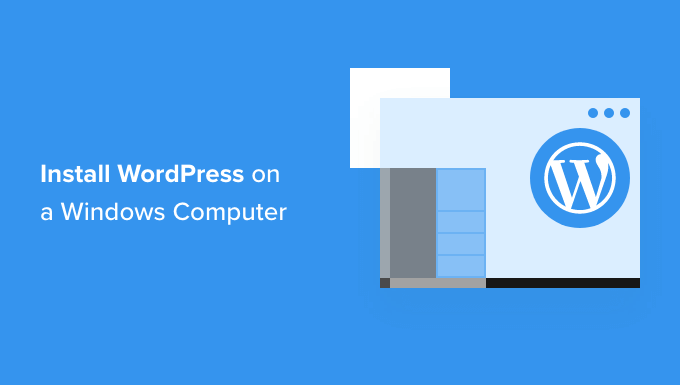
Perché installare WordPress su Windows?
Se siete utenti di Windows, l’installazione di WordPress in locale sul vostro computer offre diversi vantaggi.
Un’installazione locale di WordPress crea un ambiente di prova che non influisce sul vostro sito web reale. Questa configurazione, spesso chiamata server locale o localhost, è il vostro parco giochi personale per WordPress.
Gli sviluppatori di WordPress utilizzano regolarmente installazioni locali per il loro lavoro. Ad esempio, possono usarle per sperimentare nuovi plugin o temi o per testare il sito prima di aggiornare l’editor di blocchi Gutenberg.
Ma non è solo per i professionisti. Se siete alle prime armi con WordPress, una configurazione locale è perfetta per imparare. Potete esplorare le funzionalità, testare temi e plugin e sperimentare liberamente senza preoccuparvi di rompere un sito live.
È importante notare che quando installate WordPress in locale su Windows, solo voi potete vedere il sito. Se volete creare un sito web pubblico, avrete bisogno di un nome di dominio e di un hosting web.
Ora, tecnicamente, è possibile installare WordPress su Windows utilizzando XAMPP, e abbiamo già scritto un tutorial al riguardo.
Detto questo, abbiamo trovato due metodi ancora più semplici di XAMPP per configurare un ambiente WordPress locale, ideali per i principianti o per gli utenti che hanno bisogno di creare rapidamente un sito locale. Potete fare clic sul link qui sotto per passare al metodo che vi interessa:
Metodo 1: Installare WordPress su Windows utilizzando Studio (semplice e veloce)
Per il primo metodo, utilizzeremo Studio. Si tratta di un software locale per WordPress realizzato da Automattic, la società che gestisce e amministra WordPress.com, che è un costruttore di siti web basato sul software WordPress.
Parleremo prima di questo metodo perché è molto più rapido e semplice da seguire, perfetto per i principianti.
Innanzitutto, è necessario aprire il sito web di Studio by WordPress.com. Quindi, fate clic sul pulsante “Download per Windows”.

Una volta fatto ciò, basta aprire il file scaricato per avviare l’installazione.
A questo punto apparirà una finestra popup che indica che l’applicazione è in fase di installazione.
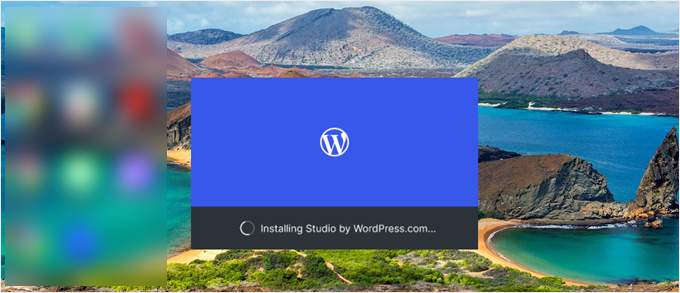
Fatto questo, si può aggiungere il primo sito.
Per farlo, basta inserire il nome del nuovo sito WordPress locale e fare clic su “Aggiungi sito”. Potete dare al sito il nome che preferite, purché vi aiuti a identificarlo facilmente.
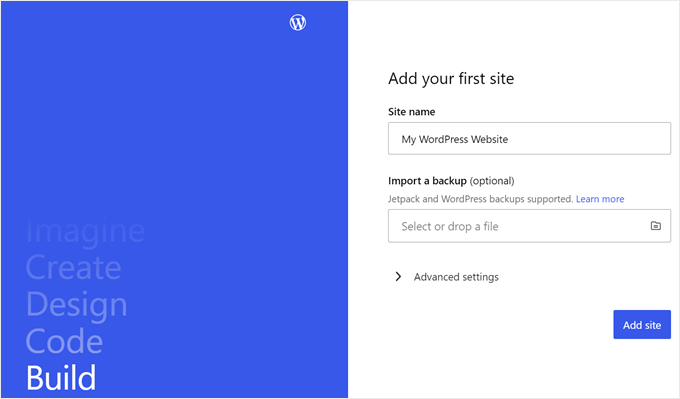
Ora dovreste vedere la dashboard del vostro sito WordPress locale.
Per accedere alla dashboard di WordPress e modificare il sito web, è sufficiente fare clic sul pulsante “Start” nell’angolo in alto a destra. In questo modo il vostro sito web locale sarà accessibile sul vostro computer.
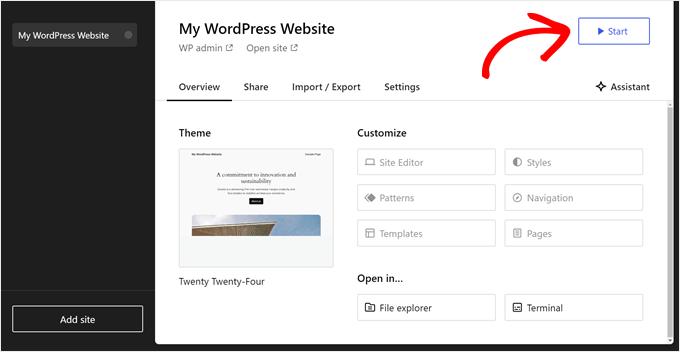
Una volta modificato il pulsante “Avvio” in “In esecuzione”, si può fare clic sul link “WP Admin” in alto a sinistra della pagina.
In questo modo si accede alla pagina di amministrazione locale di WordPress.

E questo è praticamente tutto per la configurazione. Esaminiamo le altre impostazioni che possono essere necessarie per la creazione del vostro sito web locale.
Come si può vedere nella scheda “Panoramica”, è possibile accedere immediatamente al menu dell’editor completo di WordPress direttamente dalla dashboard di Studio. Potete anche fare clic su “Esplora file” per aprire le cartelle e i file del vostro sito WordPress e fare clic su “Terminale” per gestire il vostro sito web utilizzando WP-CLI.
Se passate alla scheda “Condividi”, potete accedere al vostro account WordPress.com, clonare il vostro sito web locale e caricarlo sui server di WordPress.com. In questo modo il sito clonato sarà temporaneamente online, il che è utile per condividere siti demo con i vostri clienti o membri del team.
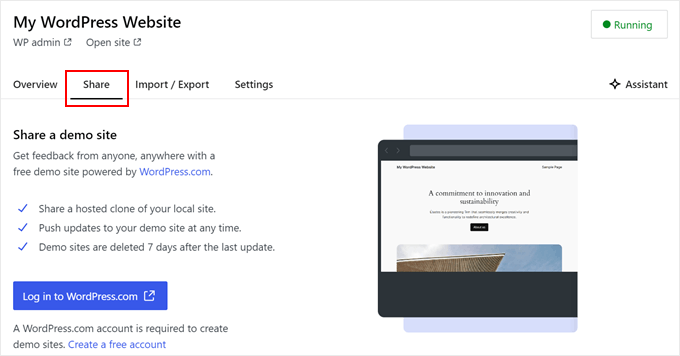
A volte si può desiderare di accedere al proprio sito web locale direttamente tramite il browser, invece di utilizzare Studio. In questo caso, è necessario conoscere le credenziali di wp-admin.
Per trovarli, potete passare alla scheda “Impostazioni” e trovare il nome utente, la password e l’URL di accesso dell’amministratore di WordPress.
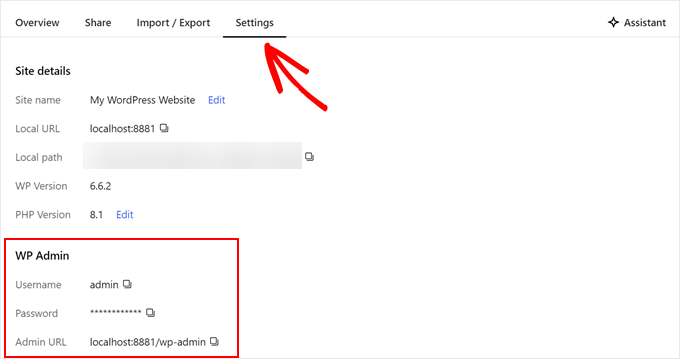
Un’altra caratteristica interessante di Studio è il chatbot AI integrato, con il quale è possibile comunicare facendo clic sul pulsante “Assistente”.
Qui è possibile chiedere aiuto a Studio per compiti come l’aggiornamento di tutti i plugin in una sola volta, l’aggiornamento della versione principale di WordPress o la creazione di codice per un blocco personalizzato.

Quando avete finito di lavorare sul vostro sito locale, passate sopra il pulsante “In esecuzione” nell’angolo in alto a destra fino a quando non appare la scritta “Stop”.
Quindi, fare clic sul pulsante per interrompere il sito web.

Un aspetto negativo di Studio è che non è possibile configurare l’ambiente WordPress a proprio piacimento. Ciò significa che dovete utilizzare la versione di PHP, il server web e il database che sono stati preselezionati per voi.
Questo può essere uno svantaggio se avete bisogno di testare il vostro sito web o plugin con configurazioni specifiche del server.
Se avete bisogno di un maggiore controllo sull’ambiente WordPress locale o di far coincidere la vostra configurazione locale con una specifica configurazione del server live, potete verificare il metodo successivo che prevede l’uso di WP locale.
Metodo 2: Installare WordPress su Windows utilizzando WP locale (più personalizzabile)
Innanzitutto, è necessario scaricare e installare il software Local WP sul proprio computer Windows. Basta andare sul sito web di Local WP e fare clic sul pulsante “Download for Free”.
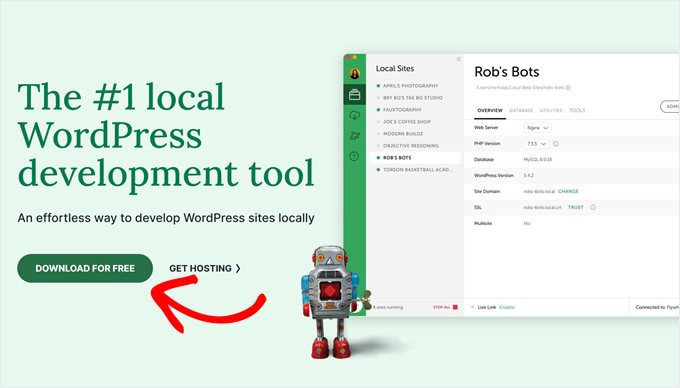
Successivamente, apparirà una finestra popup in cui dovrete selezionare la vostra piattaforma. Scegliete “Windows” dal menu a discesa.
Successivamente, è possibile inserire i propri dati, come nome e cognome, indirizzo e-mail di lavoro e numero di telefono, per scaricare il software.

Dopo aver inserito i dati, è sufficiente fare clic sul pulsante “Ottieni ora”.
Successivamente, il software verrà scaricato automaticamente nel computer. Altrimenti, è possibile fare clic sul link “clicca qui” per avviare il download.

Una volta scaricato il file, avviate la procedura guidata di installazione.
A questo punto, dovrete selezionare se volete installare il software per tutti gli utenti o solo per voi.
Una volta selezionata un’opzione, fare clic sul pulsante “Avanti”.
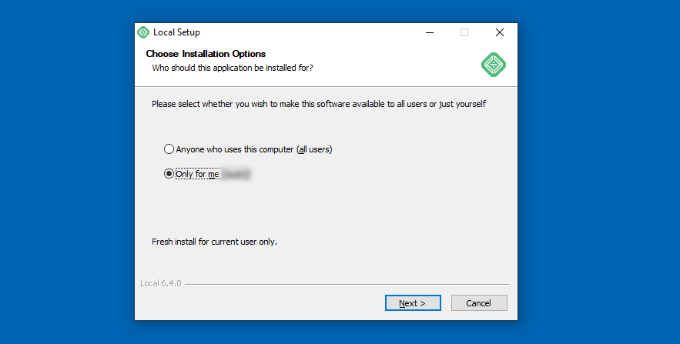
Nel passaggio successivo, è possibile selezionare la “cartella di destinazione” in cui verrà installato il software.
È sufficiente fare clic sul pulsante “Sfoglia” per impostare il percorso e quindi fare clic sul pulsante “Installa”.
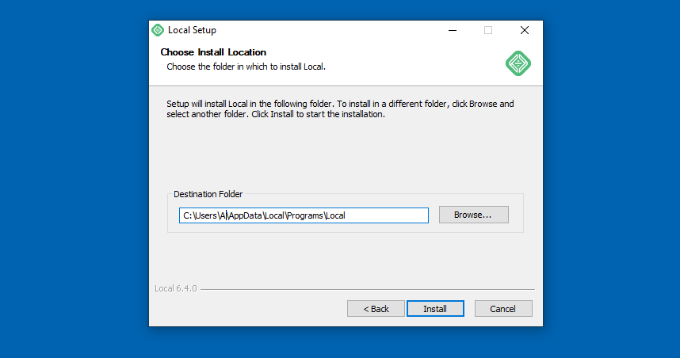
Il software Local WP viene ora installato sul computer Windows.
Una volta terminato, è possibile selezionare la casella di controllo “Esegui in locale” e fare clic sul pulsante “Fine” nella procedura guidata di installazione.
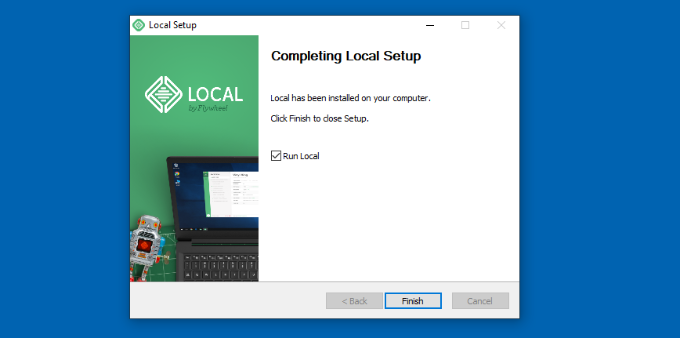
A questo punto il software si avvia sul dispositivo Windows.
Il passo successivo consiste nell’aggiungere un nuovo sito web locale. Per farlo, è sufficiente fare clic sul pulsante “+” in basso.
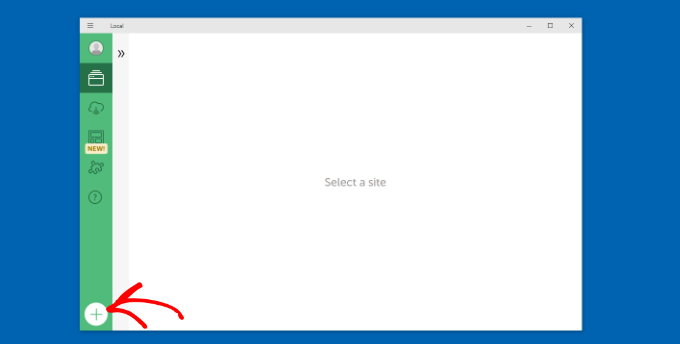
Successivamente, è possibile creare un sito nel software Local.
Selezionare l’opzione “Crea un nuovo sito” e fare clic sul pulsante “Continua”. È possibile creare il sito partendo da un blueprint o da un file di sito esistente, ma a scopo dimostrativo sceglieremo la prima opzione.

Successivamente, è possibile inserire un nome per il sito web locale, ad esempio “Il mio sito WordPress”.
Sono disponibili anche opzioni avanzate in cui è possibile inserire il dominio del sito locale e il percorso del sito locale. Per impostazione predefinita, il dominio utilizzerà il titolo del sito web, ma separato da trattini.
Una volta terminato, è sufficiente fare clic sul pulsante “Continua”.

Successivamente, è necessario scegliere un ambiente per il sito web locale.
È possibile utilizzare l’ambiente “Preferito”, in cui il software selezionerà automaticamente la versione di PHP, il server web e la versione di MySQL. D’altra parte, si può anche selezionare “Personalizzato” e inserire i dettagli dell’ambiente.
Local WP offre le ultime versioni di PHP. Per quanto riguarda il server web, è possibile scegliere tra Nginx e Apache. È inoltre possibile scegliere tra MySQL o MariaDB per i database.
Si noti che alcune versioni di PHP, server web e database richiedono il download di alcune dipendenze per funzionare correttamente.
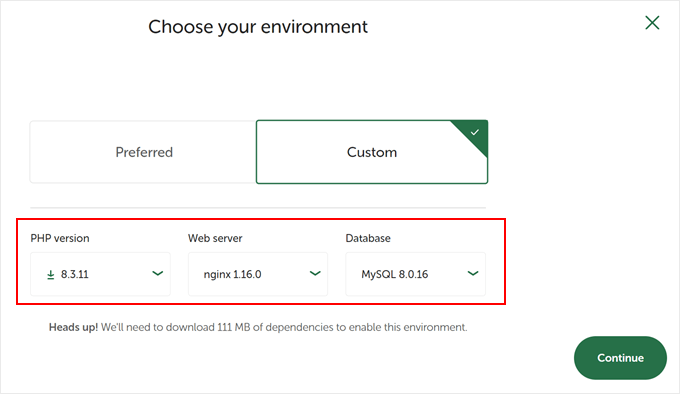
Successivamente, è possibile inserire un nome utente e una password di WordPress per il sito web locale. Inoltre, è possibile scegliere un indirizzo e-mail di WordPress per ricevere tutte le notifiche via e-mail.
Oltre a questo, c’è un’opzione avanzata in cui il software vi chiederà se avete una rete WordPress multisito. In caso contrario, basta fare clic su “No”.
Dopo aver inserito questi dati, è sufficiente fare clic sul pulsante “Aggiungi sito”.
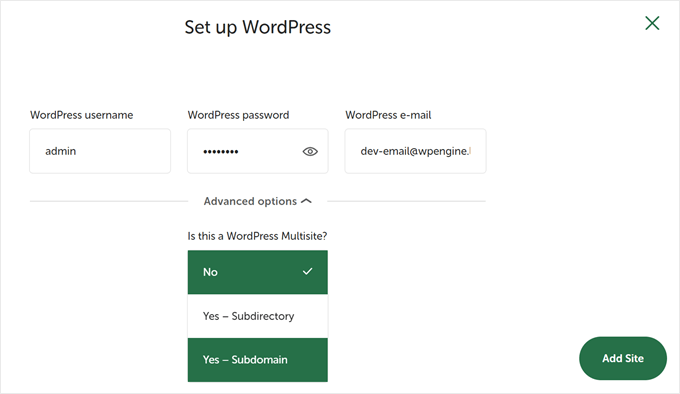
Il software installerà ora WordPress e configurerà il vostro sito web.
Per avviare il sito web locale, fare clic sul pulsante “Avvia sito” nell’angolo in alto a destra.
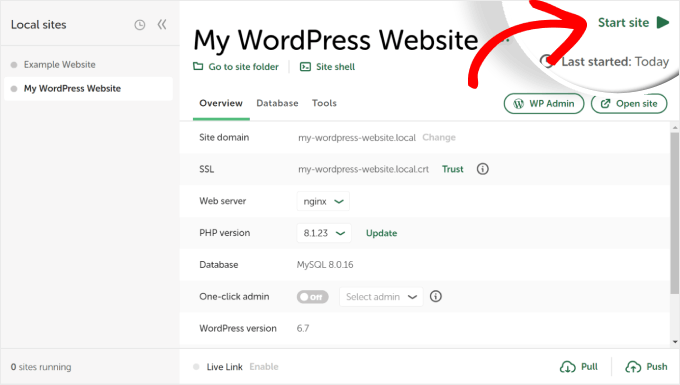
Quindi, fate clic sul pulsante “WP Admin” e vedrete la pagina di accesso all’amministrazione di WordPress.
È sufficiente inserire il nome utente e la password immessi in precedenza durante la configurazione del sito web locale, quindi fare clic sul pulsante “Accedi”.

Ora è possibile modificare il sito web locale sul computer Windows.
Una volta terminato, non dimenticate di fermare il sito web dal software Local WP facendo clic sul pulsante “Stop site”.
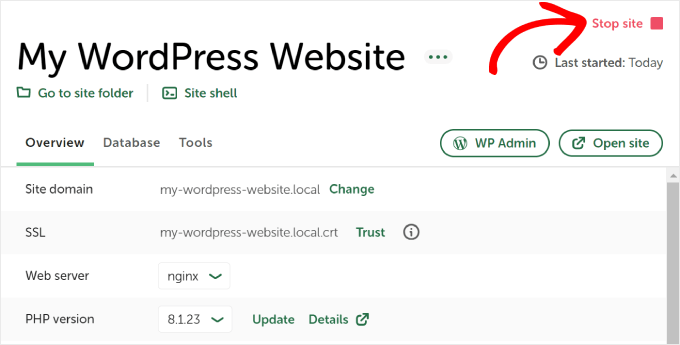
Suggerimento: se si desidera saltare il processo di login, è possibile abilitare il login dell’amministratore con un solo clic in Local WP.
Per farlo, basta tornare alla dashboard di WP locale e attivare il pulsante “Amministratore con un solo clic” fino a quando non appare la dicitura “On”. Quindi, nel menu a discesa, selezionare l’utente amministratore che può utilizzare questa funzione di accesso con un solo clic.

Alternativa: Usare WordPress Playground per testare temi, plugin e altro ancora
WordPress Playground è uno strumento innovativo che consente di sperimentare WordPress direttamente nel browser web. Si tratta di una sandbox virtuale in cui è possibile provare nuovi temi, plugin e funzionalità di WordPress senza influire su alcun sito web reale.
WordPress Playground si differenzia da un ambiente WordPress locale per diversi aspetti fondamentali.
Innanzitutto, non richiede l’installazione sul computer e si ripristina dopo ogni utilizzo, a differenza delle installazioni locali permanenti. È possibile accedervi da qualsiasi dispositivo dotato di browser, mentre le installazioni locali sono legate a un solo computer.
Mentre WordPress Playground è ideale per test e apprendimento rapidi, un ambiente WordPress locale sul vostro computer Windows offre maggiore flessibilità per progetti di sviluppo a lungo termine.
Per una guida dettagliata, consultate la nostra guida su come utilizzare WordPress Playground nel browser.
Ho installato WordPress sul mio computer Windows, e ora?
Ora che avete WordPress sul vostro computer, ecco alcune cose che potete fare:
- Imparate i suggerimenti e i trucchi di base di WordPress per utilizzare meglio il vostro sito.
- Provate diversi temi di WordPress per vedere come può apparire il vostro sito.
- Installate e testate i plugin WordPress indispensabili per aggiungere nuove funzionalità al vostro sito.
- Imparate a risolvere gli errori più comuni di WordPress da soli.
- Provate diversi page builder drag-and-drop per dare al vostro sito un aspetto gradevole.
- Imparate a reimpostare la password di amministrazione di WordPress su localhost per recuperare l’accesso al vostro sito.
- Impostate flussi di lavoro automatizzati per semplificare la gestione del sito.
- Imparate a conoscere la sicurezza di WordPress per mantenere il vostro sito al sicuro dagli hacker.
- Spostate il vostro sito WordPress locale su un server live quando siete pronti a condividerlo con tutti.
Speriamo che questo articolo vi abbia aiutato a capire come installare WordPress in locale su un computer Windows. Potreste anche consultare il nostro articolo su come installare WordPress in locale su un computer Mac e la nostra guida definitiva alla creazione di un sito di staging per WordPress.
Se questo articolo vi è piaciuto, iscrivetevi al nostro canale YouTube per le esercitazioni video su WordPress. Potete trovarci anche su Twitter e Facebook.





Bidyut Kumar Mondal
Thanks a lot for such a wonderful post.
Ali
Just to say Thank you very much.
sreenu
thank you…thank you soooooooooooo much ..
Nissim
Thank you so much. this was sterling
adriana
OMG i made it through. lol. thank you for your time writing this, it helped me through the panic stage lol
mahendra
Who help of peoples, They are God
Kenneth Ekeh
Help please! I have followed the article and installed wamp, created the wp database but culd not be able to run complete configuration of wp. Its telling me “can’t select database”. Try Again. Please help me to fix this. Thanks.
WPBeginner Support
During the installation when it asks for your database details, please make sure that you are entering the same name for the database which you used when creating database in phpmyadmin. For username, use root and leave password blank.
Admin
Tom
Upon opening mysql workbench, choose your connection, then write the code without quotes “create database nameofyourdatabase;” this will be the name of your database and what you will use in the wordpress setup when it asks for the name of your 1)database(use nameofyourdatabase) 2)username 3)password 4)database host(im using “localhost”)
Hope this helps.
Tammi L. Coles
Just a quick note of thanks for this very simple-to-follow tutorial. It worked like a charm (including the Apache rewrite for permalinks follow-up).
ogunmakinwa dayohanks.
Your tutorials as been good for me so far, but please which stable wordpress can i download? can i download the latest version? i am just thinking that some plugins might not be available for the latest version.. so for now which version do you recommend for me? thanks
WPBeginner Support
We always recommend using the latest stable version of WordPress.
Admin
Mohamed Ishag
Hi there,
Would you please answer the question posted on 12/11/13 I still need help
as I am unable to run the WAMP Server on Windos 8. Please read question posted on 12/11/13.
Thank you in advance.
Regards,
Mohamed
Orestes
I was able to install WP, but I’d like to know how to manage different web logs within my local server. Thank you for the instructions and tutorials here.
WPBeginner Support
you can install different weblogs (blogs or websites) on the same server by installing wordpress in different sub-directories inside your
/wamp/wwwfolder. For example:C:\wamp\www\site-1 will open in http://localhost/site-1
C:\wamp\www\site-2 will open in http://localhost/site-2
Admin
GinoDC
After entering details for Site Title, Username, Password and Email I press Install WordPress and my computer hangs. Please help.
WPBeginner Support
This could happen for a number of reasons. Try to uninstall wampserver and then download and reinstall again. If the problem presists, then you can try XAMPP.
Admin
Mohamed Ishag
Hello,
I have installed WAMP on Windows 8 but I am having a problem creating a data base due to the following error (You don’t have permission to access /phpmyadmin/ on this server). I have edited the htpd.conf file as follows
Open file httpd.conf through wamp tray icon
Find:
# onlineoffline tag – don’t remove
Order Deny,Allow
Deny from all
Allow from 127.0.0.1
Change to:
# onlineoffline tag – don’t remove
Order Deny,Allow
Allow from all
Then saved but still get the same error, why!? Norton 360 is installed on the PC
and no other conflicting apps. I need some help to fix this issue. Any ideas? Thank you in advance.
Best Regards,
Mohamed
Mohamed Ishag
Dear Syed and the team,
Thank you very much for this site. I am new to WordPress and found your tutorials and explanation very good and straight forward. I feel that you are a busy man but still have time to dedicate this site to new WP beginners. God bless your parents.
Salam,
Mohamed
adam
Hello,
I have installed everything and am finally at my wordpress dashboard on my localhost machine. everytime i click on visit my site to view what I have changed the page simple directs to the WAMP server configuration screen that shows apache version, php version, loaded extensions, etc… It seems that something simple needs to be changed but I dont know…Can anyone please help? Thanks in advance…
WPBeginner Support
You have probably installed WordPress in www directory. You need to install it in a subdirectory like www/testsite1/
Admin
Nuno
Hey i have the same problem, so if i just copy all the files to a subdirectory it will work or do i have to reinstall it all over? Thanks.
Matthew
Thank you, than you, thank you. I am a technophobe and your clear instructions helped me all the way.
Arthur
Hi,
After installing WAMP in accordance with your instructions, I could not open phpmyadmin; explorer kept waiting for localhost. I’m not a pc techie so I desperately need instructions how to proceed furter in the same easy way as your manual above. I have a 64 bit W7 machine, and installed the 64 bit version of WAMP first, but since that did not work as described , I installed the 32 bit, but with the same result. Thanks for your help in advance ! (No Skype, port 80 OK, as far as I can see)
WPBeginner Support
Try restarting all services make sure that WAMPServer icon is green also make sure that Skype is not running in the background. Also look at this support thread for more possible solutions.
Admin
Arthur
Thanks a lot: I followed your recommended thread and I removed a double line in the Host file (‘127.0.0.1 Localhost’) that seemed too much and now I can get to a log-in page of phpMyAdmin, which is great, but I have not yet even entered an ID and password during initial installation of WAMP. Did I miss something ?
Thanks for your patience again…
WPBeginner Support
To log in to phpMyAdmin, enter username root and leave password blank.
Trudy Ritsema
Can I run more than 1 test site on WAMP? and any ideas of how I would go about this please?
I already I have localhost site running – and I don’t want to get rid of that yet as I am still developing it…
Thanks in advance.
WPBeginner Support
in your www directory create new directories for each website. That way you can run multiple sites on localhost.
Admin
viki
i can’t create new database, bcause it is showing ” * No Privileges” in red colour letters. please help me
WPBeginner Support
you are probably entering wrong credentials to connect to your mysql database.
Admin
nick mav
you should login using the following credentials:
username: root
password: [empty] –> that is, no password
Shawn Morrissey
Thanks Nick,
I had the same issue and couldn’t find this out anywhere I had looked previously…
SanketP
Hi. I am a new-bee to this world of eb designing. Wanted Joomla but that didnot go thru too well. WP instal was as good for me. Thank you. XOXOXO.
Everett
Hello. I want to be able to develop my wordpress site locally and not have to be connected to the web when I make changes and do save or update inside wordpress. Before I go through all the installation of WAMP and WP locally, can anyone tell me if I will have to have internet access to make updates to a wordpress running locally in WAMP? Sure I realize if I wanted a new Theme or Plugin, I would have to be online, but if I am just making adjustments to text and adding pictures that are already on my laptop, etc. will I have to have internet access to do so? I ask because I do a lot of travel where I am on an airplane and could be working on a new version of a website if I don’t have to be online. Also, I can’t afford a wireless account for my laptop, so I only have internet when I am at home with my own wifi or when I am somewhere that has a free wifi. Thanks.
WPBeginner Support
no you do not need an internet connection to work locally on your website.
Admin
Ian
I followed the instructions to the letter, installed WAMP and the required SP1 Visual C++ on a brand new laptop running Windows 8 64bit. The installation refuses to launch, brings up a screen asking if I’m sure I want to let this programme make changes to the computer, then does nothing when ‘Yes’ is clicked. What is going wrong?
WPBeginner Support
Does the wampserver icon appear in your windows taskbar? If it does, then you need to click it and launch wampserver.
Admin
Brynn
Please help. I installed WAMP but when I went to open phphMyAdmin, nothing happens. I tried uninstalling and reinstalling, but still getting the same problem. I’m not even getting any sort of popup block notification in my browser. Just nothing.
I wonder if this might have something to do with the WARNING window that popped up on the WAMP website before I downloaded it… It said something in French, and then something about needing to install C++ which I know nothing about, and which was not mentioned in this tutorial.
Do I need to install C++ and if so, do I need to learn how to use the programming language before I can finish this tutorial on installing WordPress? I am a designer, not a programmer, so I hope to god I don’t need to stop everything and go learn C++ before I can do a simple WordPress install.
WPBeginner Support
Brynn you can always check whether or not Microsoft Visual C++ is installed on your computer from Control Panel -> Programs and Features. Do you see wampserver page when you visit http://localhost? If you do, then you have already successfully installed WAMP.
John Victor
Can I hug you now or later?
Anudeep
Awesome tutorial
guru
I install wordpress to my localhost. But i dont know to use it to develop a site. I’m new to wordpress. Please anyone help me.
WPBeginner Support
Take a look at our beginner’s guide section. For theme development you may want to take a look at our WordPress theme cheat sheet for beginners.
Admin
Scott Cho
Got WAMP installed, but when I try to create a new databse by clicking on the phpMyAdmin button in WAMP the chrome browser window that opens up says:
Forbidden
You don’t have permission to access /phpmyadmin/ on this server.
Can anyone point me in the right direction as to what this is and how to fix it? I don’t know if this makes a difference but I have it installed on my secondary hard drive, not my C drive (the c drive just has my operating system).
Asad Riaz
Here is how you edit the htpd.conf file
Open file httpd.conf through wamp tray icon
Find:
# onlineoffline tag – don’t remove
Order Deny,Allow
Deny from all
Allow from 127.0.0.1
Change to:
# onlineoffline tag – don’t remove
Order Deny,Allow
Allow from all
Plus resolution to some other conflicts
Make sure no other program conflict wamp such as Xampp, phpEasy, IIS, Skype, Zonealarm, firewall/antivirus, NOD32, Eset, any web and/or Remote Desktop related program, such as Teamviewer …
IIS and Apache/Wamp are both web server and might conflict in some way, so you have to disable IIS in order for Wamp to work
Disable IIS in Vista/W7:
Control Panel, Uninstall Programs, Turn Widows Features On or Off, uncheck Internet Information Services
Disable IIS in XP:
Control Panel, Add/Remove Programs, Add/Remove Windows Components, uncheck Internet Information Services (IIS)
Restart computer, then restart Wamp
Also, in folder C:\WINDOWS\System32\drivers\etc, open file hosts and delete anything in this file and have only this line below and nothing else
127.0.0.1 localhost
If using Skype, go to Tools->Options->Advanced->Connection and uncheck the box “Use 80 and 443 as alternatives for incoming connections”. Restart Skype after WAMP. Now you will be able to use both programs at the same time w/o problems.
I hope it helps, found it on net
Asad Riaz
Howdy,
Well i have managed to install it using the article. Some info was missing in this article like
1. Once you click on phpMyAdmin, it asks for login details, so here they are:
username: root
pass: (leave it blank)
2. WAMP sometimes gets offline and it wont open the phpMyAdmin page, so you guys need to edit the htpd.conf file in C:wamp/bin/apache4.2/conf/htpd
Lets see now how much it helps me.
I m here for all the support that i can extend.
Thanks to the author of this page.
Cesar M.
thanks for the user info I was getting crazy, but I finally got in to phpmyadmin
Colin Teasdale
Hiya,
Problem solved – I had needed to install the Visual C# redistributable, and did that after installing Winamp. Uninstalled Winamp, rebooted and then re-installed – everything fine. That’ll be user error then ! ! !
Colin T.
Scott Cho
I’m getting the same error you just described below, where is this redistributable you speak of?
Colin Teasdale
Hi guys,
I’ve just downloaded and installed WAMP and have got to the “set up a database” stage. When I select ‘phpMyAdmin’ I get a ‘Firefox Problem Loading Page’ page with “Unable to connect – Firefox can’t establish a connection to the server at localhost”.
I’ve tried the fix suggested by Imran on June 17th, but this doesn’t seem to have fixed resolved the problem.
Any thoughts on how I fix this, please??
Peter
Hi Editorial Staff,
Do you have a tutorial that is the reverse process also using WAMP? I have a functioning website that I would like to duplicate on my home computer for experimenting and learning css, and php programming without risking my functional website.
Thanks.
EL
That is exactly what I need!
Denzil
Hi, a very useful article, thanks. Is it easy to migrate a test WP site on WAMP to a hosted site elsewhere? Do you have a tutorial article to help?
Thanks
Editorial Staff
Yes, it is fairly easy to do that. Tutorial will be coming tomorrow
Admin
Denzil
Great! How timely! Thanks guys, looking forward to it.
Kate BP
Absolutely cracking article – really helpful, thanks so much!
akash
After clicking on phpmyadmin,,,,,,,
i am getting redirected to directly php my admin webpage and not the database entry option which is shown above.
thereafter the details are not matching afterwards in database,username and password.please give me its solution as soon as psbl.
Amitoj Gautam
User Name: Root
Password: None (Leave this space empty)
Click on the Go button. You will be directed to the page you are looking for.
Dana
Hi! Once I’ve created a site on my WAMP server, could I then transfer it to an existing domain name? I’m trying to create a new site without shutting down the old one. Once the new one is finished, I would want to replace the old one, but use the same domain name. Thank you!
Editorial Staff
Yes you can do that. We have updated the article to add a link to the tutorial.
Admin
vahid
Thank you so much
chris martin
Hi, I am having trouble with links not working. Could you help me or give me some direction on how to fix that? On my site “chrisjamesmedia.com” click menu, then “blog” and i get “not found”. This also happens with links as well.
Also, do you have a tutorial on how to host multiple domains from this as well, or point me in the right direction.? I have looked up several things about virtual domain, localhost, and everytime I find something they want me to edit httpd conf, but what they have doesnt match mine.
Thank you so much!!!!
Tamsin
Hi,
Great article, very clearly explained.
Would you be able to tell me the best way to add a second WordPress site to Wamp? I have read a lot of conflicting information and would rather not make a massive mess of things!
Editorial Staff
Create a new folder inside your www folder, then repeat this process.
Admin
Tom Smith
Hi,
Thank you for providing this excellent tutorial! It’s going to be great to get use to using WP onn my PC before I install it on my host server and create my website.
I followed your instructions and installed WAMP and then WordPress and got all the screens you showed here… and with the tweaking you suggested, I was finally able to open WP – saw the Dashboard, etc. Then I closed it.
But now I can’t seem to open WP. I open WAMP and click on Localhost – and it just sits “waiting for response from localhost” – does not open anything. I’ve tried http://localhost/my database name – it will not open – I get “HTTP 500 Internal Server Error”. Just in case, I also followed your instructions on SKYPE and unchecked that Port 80 box.
What am I missing?
Editorial Staff
Did you shut down your computer? You have to launch WAMP Server every time you restart your computer.
Admin
Imran
When i try to Setting Up a Database for WordPress, it was saying like this : Forbidden
You don’t have permission to access /phpmyadmin/ on this server. what is the reason ? can you please guide me. thank you in advance….
Editorial Staff
That’s weird. Since you are the admin of your Wamp install, then you shouldn’t get this error.
Admin
Imran
Finally i got the solution…
I think it will be useful for others.
for phpmyadmin
Goto c : wamp/alias/phpmyadmin.conf file, open with notepad.
find
Options Indexes FollowSymLinks MultiViews
AllowOverride all
Order Deny,Allow
Deny from all
Allow from 127.0.0.1
replace with
Options Indexes FollowSymLinks MultiViews
AllowOverride all
Order Deny,Allow
Allow from all
thats it…
Imran
Thank you very much EDITORIAL STAFF, this is a nice post and very usefull.
Melanie
I had this same problem with the phpmyadmin and I found and made the changes cited here to the alias file, then restarted WAMP and I was able to create my database. However, now I’m getting the same Forbidden message when I try to install WordPress on my localhost, exact text below:
Forbidden
You don’t have permission to access / on this server.
I can get to the WP install screen from 127.0.0.1, but not localhost. I’m running Windows 8. Any ideas on how to get this to install? Thanks in advance for any help you might be able to give me.
Akshay
Hi.
I wanted to use this method to test out plugins before installing then on my live site. So in your tutorial, instead of copying in clean WordPress files, I copied in a full backup of my site made using BackupBuddy.
However from this point on I’m not sure what to modify in order for my site to function correctly offline. I edited my wp-config file to the new database details, and imported my database from my online phpmyadmin to the WAMP one. However it seems like there’s something I’m missing, as when I try to access localhost/site/wp-admin I am redirected to my online login page.
Do you have any suggestions?
Thanks very much for your help.
Akshay
Brandi
I’m in the same boat – did you ever find a solutions?
Christophe R.
Another (lazy) point for XAMPP : I know there are some differences in the config files, but I use both linux (at home) and Windows (Seven and 8) at work, so I appreciate having the same interface for I only have to learn once.
Andre
Great article and easy instructions for those who want to venture into WAMPP….however, for myself, I still prefer XAMPP and do run it on it’s own on a second drive without the installable version. Updating is a breeze, although I rarely need to.
I’ve used XAMPP for many years now for both WordPress and Joomla theme development, as well for a testing server. Never had issues and I do find it quite easy to use. I used to use the full version but I found that the Lite version works extremely well.
I noticed someone said AMPPS, but I’ve never tried that…perhaps in my spare time I will try it out.
Nicholas
Its click and install that’s how easy it is and just open to localhost/ampps i use it for all my scripts that this includes as downloads and install on the service. no worries on xamp and wamp that i found to limited in some ways.
Adrian
Thanks alot it was really helpful
Thomas
Hi everyone,
I’m a very beginner with WordPress and I have created a site with it and WAMP on my computer.
Now I want to put it online, but I don’t know how to do it.
Where does a tutorial exist for that?
The thing is that I want to replace the current site, which is hosted somewhere else, and so keeping the domain name.
Does anyone know where I can find this kind of information?
Thanks a lot!
Nicholas
WAMP in the older days was great! Now there is a far more better and less embarrassing way when it comes to configuring things with WAMP. WAMP is in the past and gone for me. I use AMPPS far more better no configurations, just install and a few dips of changes in the options section that’s it. Open your browser go to your localhost and install any cms or other scripting lang within your browser using ampps. You’ll be amazed! No more downloading then extracting in www folder and then reconfiguring. WordPress is just a click and install on ampps. No hassle! Shouldn’t you guys write something about AMPPS? This is a lot more better than WAMP! WAMP lags a lot of things like cgi and stuff those are extras, but on ampps everything is included. Ever since ampps I never looked back to wamp! Sorry!
Editorial Staff
Have been using WAMP for so long that didn’t even bother with another option. AMPPS sure looks good. Good to see that it is made by the folks from Softaculous. Will have to give it a try.
Thanks for the suggestion Nicholas.
Admin
Zimbrul
Why do you say you prefer WAMP over XAMPP?
Alexander Gounder
WAMP is much simpler and easier to use compared to XAMPP.
Editorial Staff
Would second that. WAMP is easier to use. Several years ago when we used XAMPP the upgrade process was complicated and it was buggy. We switched over to WAMP and it was awesome.
Admin
Parth S.
Hi, Thank you very much for this. It’s very informative and easy to follow. However I’d suggest you mention the skype thing a lil early around the localhost point, because, there ppl start to worry when they see a blank screen with skype on in their PC.
Great post though. Keep it up.
Mladen
Just to mention, that Team Viewer also causes problems with WAMP.
Christophe R.
I actually do prefer XAMPP and DTX-Control for I can overcome security policy : Installation without administration rights (zip file pour the web server) and full access to blocked ports (80, 443, 3306).